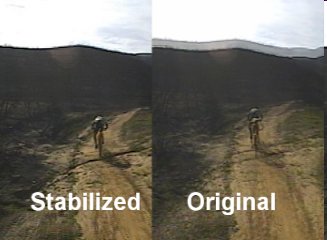 Steps
for making videos
Steps
for making videos|
Back to the videos page for |
 Steps
for making videos
Steps
for making videos1. Equipment for recording videos, clockwise from the helmet:
 This is what it looks like when you put it all together |
My first videos were made by putting together a string of clips that I recorded from my digital camera. That's a good way to get started if you already have a digital camera and don't want to spend a hunk of cash on a camcorder and the helmet camera.
2. Copy video to your computer. You'll probably need to buy a cable for this, either a USB-2 or Firewire. Check the camera manual to see what kind you'll need. Also make sure your video capture program, probably part of your video editor, supports the appropriate port on your computer. My video capture program only supports the Firewire port. You'll need lots of disk space on your computer. Mini-DV takes about 20 GB per tape, then that gets doubled when you generate the stabilized version (next step).
 3.
Stabilize the video. This is an important step - it makes the video much
more watchable and less likely to make your audience toss their cookies.
I use a program called SteadyHand
from goodervideo.com.
It's well worth the cost! On the right is a link to a short video clip that
shows the same video as recorded and after stabilization. The downside of stabilization
is that you loose a lot of the sense of speed. That is compounded by the default
settings on SteadyHand that vastly overstabilize so that you feel like you're
watching from a flying carpet as it floats down the trail. These are the
settings I use: Horizontal 100, Vertical 200, Zoom 0, Rotation 100.
3.
Stabilize the video. This is an important step - it makes the video much
more watchable and less likely to make your audience toss their cookies.
I use a program called SteadyHand
from goodervideo.com.
It's well worth the cost! On the right is a link to a short video clip that
shows the same video as recorded and after stabilization. The downside of stabilization
is that you loose a lot of the sense of speed. That is compounded by the default
settings on SteadyHand that vastly overstabilize so that you feel like you're
watching from a flying carpet as it floats down the trail. These are the
settings I use: Horizontal 100, Vertical 200, Zoom 0, Rotation 100.
4. Editing the video. There are many video editors available for less than $100. I chose one after reading a lot of reviews, including customers' comments on Amazon.com, and ended up picking Video Explosion Deluxe, made by Nova Software Development.I think it was a great program but it is no longer available. Sony has taken it over and calls it Vegas Movie Studio and they have made it even better over the years. The latest version (10.0, as of August 2010) has video stabilization built in (as well as a number of other great improvements), but you can't stabilize batches of video as you can with SteadyHand. On the other hand, stabilization works with all formats of video including high def, not just DV as the version of SteadyHand that I use can process.
Be prepared to spend a lot of time with your video editor. It takes a lot of effort, more than many people have time or patience for. Expect to spend several hours to put together a 10 to 20 minute video if you want it to come out well.
5. Upload to your web site. The videos I make are encoded at about 600 Kbits/second. This is pretty highly compressed and makes the videos a bit chunky as you've probably noticed. However, it makes the files small enough that you can watch them while downloading if you have a high-speed internet connection. Even so, the files are very large, roughly 5 MB per minute of video, so you'll need a web site with lots of disk space if you're going to be making many of them.
My friends Tony and Yongky put together the first biking videos I saw. They were a lot of fun to watch so I thought they would be a lot of fun to make as well. There are a number of web sites that provide videos - one of my favorites is petefagerlin.com